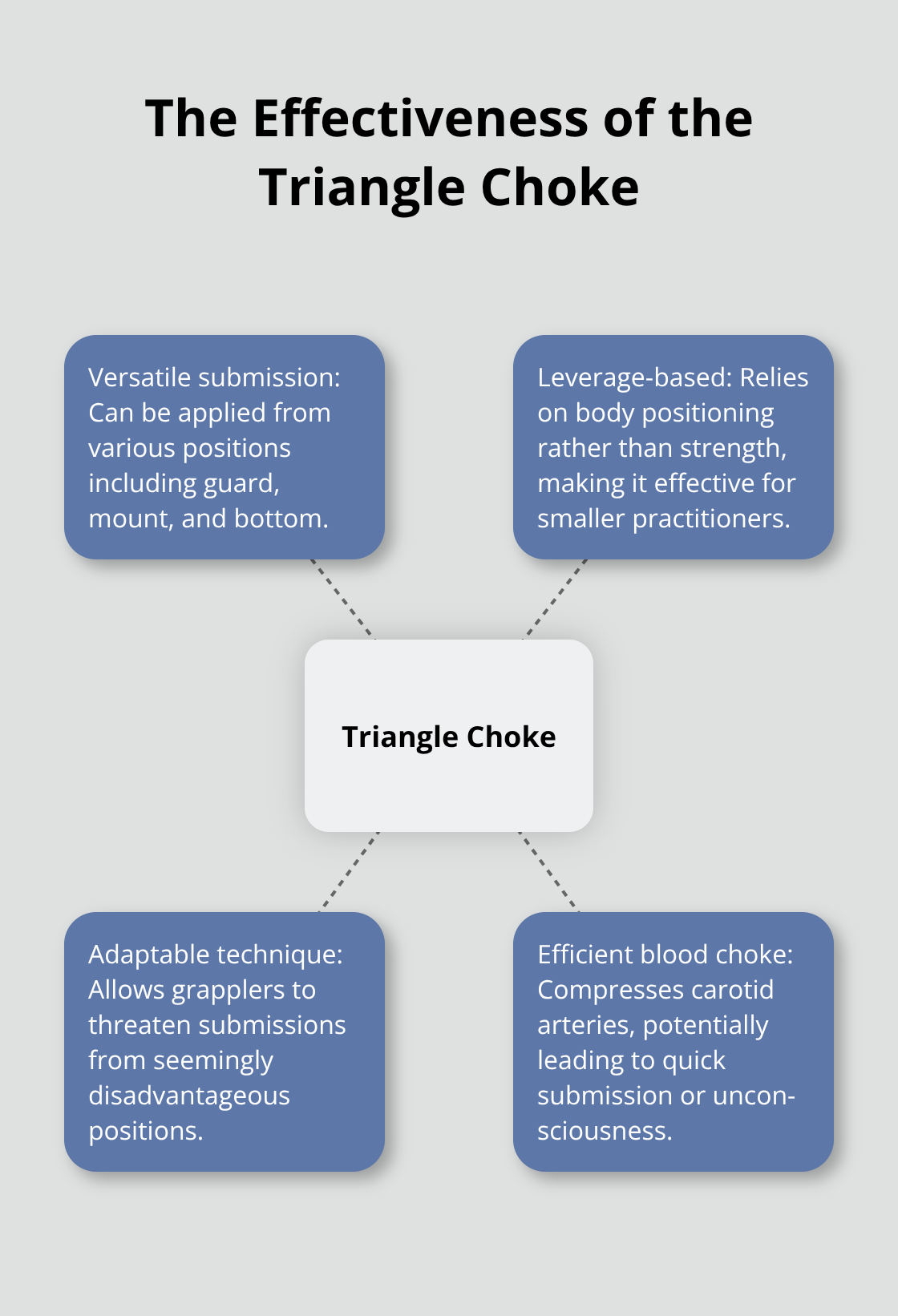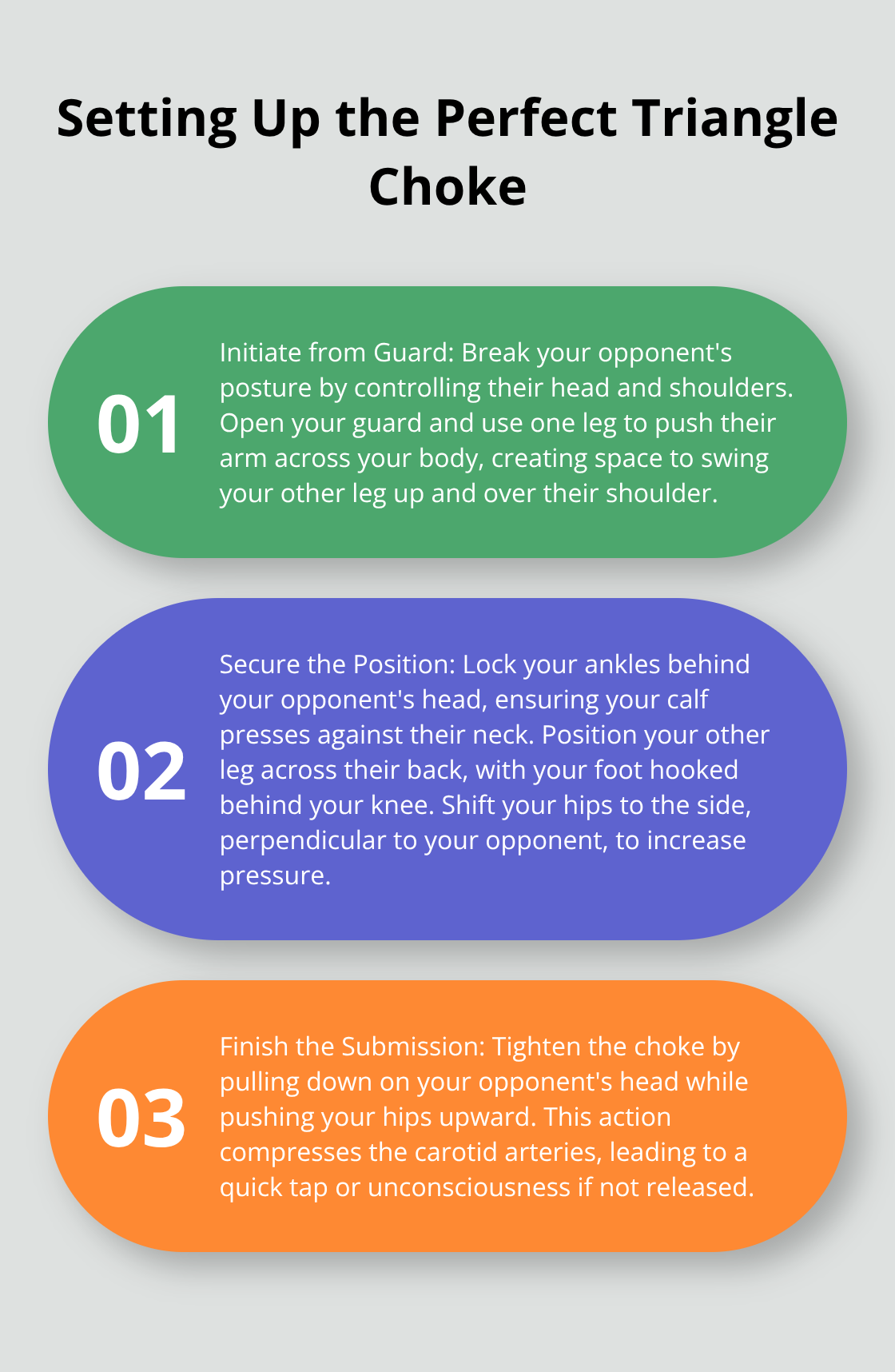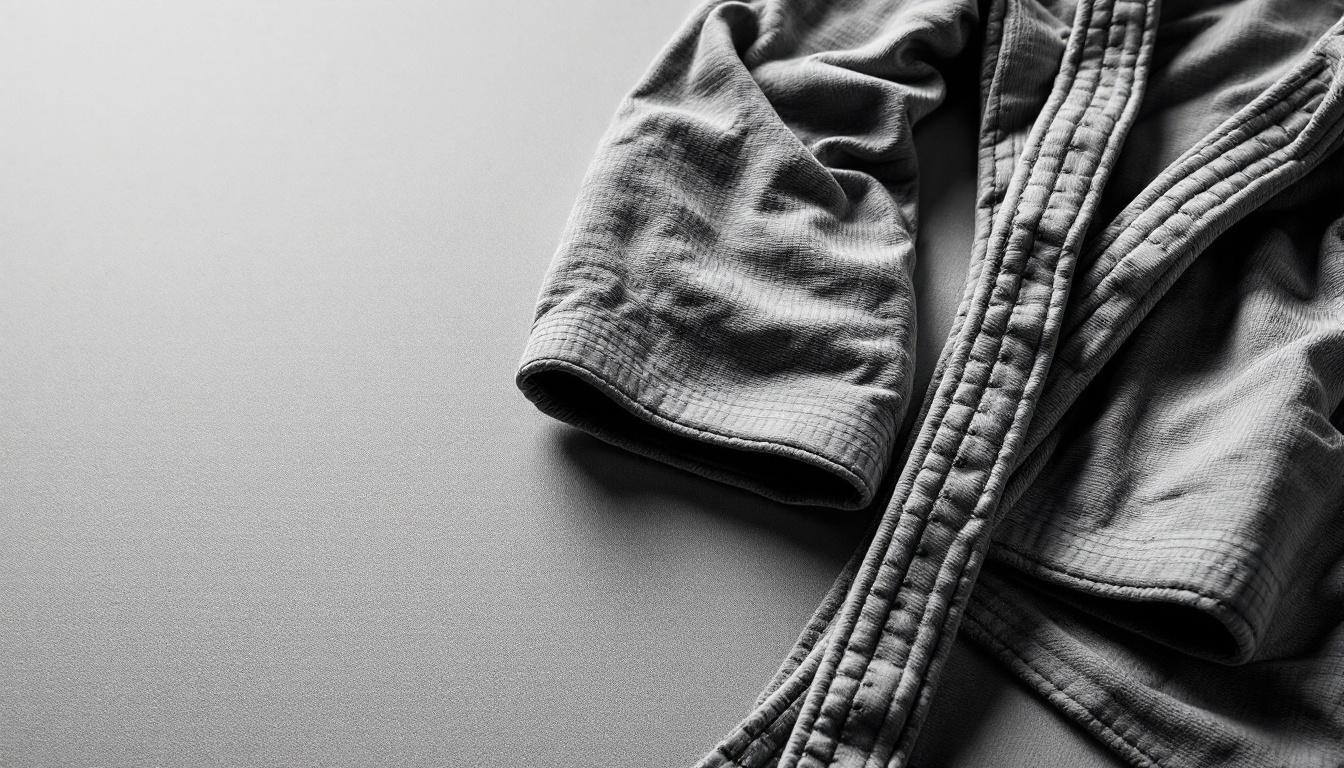At Jiu Jitsu, we know the triangle choke is a game-changer in grappling.
This powerful submission technique has become a cornerstone of Brazilian Jiu-Jitsu, revered for its effectiveness and versatility.
In this post, we’ll break down the Jiu Jitsu triangle, from its basic mechanics to advanced variations, helping you master this essential move.
What is the Triangle Choke?
The Mechanics of the Triangle
The triangle choke stands as a formidable submission technique in Brazilian Jiu-Jitsu (BJJ) that has transformed grappling sports. This choke utilizes the attacker’s legs to form a triangle shape around the opponent’s neck and arm, effectively cutting off blood flow to the brain and forcing a submission.
To execute a triangle choke, the attacker traps one of the opponent’s arms between their legs. They wrap one leg around the neck and position the other across the trapped arm. The free leg then locks behind the knee of the leg encircling the neck, creating a tight triangle shape. This position compresses the carotid arteries, potentially leading to unconsciousness if not released.
A Brief History
The triangle choke’s roots in BJJ trace back to the Gracie family in Brazil. In the following decades, the Gracies, supported by their upper class peers and by a nationalist regime, launched a comprehensive process of jiu-jitsu development. The triangle evolved into a staple in BJJ competitions and later in mixed martial arts (MMA) events.
The Triangle’s Effectiveness
The triangle choke’s popularity stems from its versatility and efficiency. Unlike many submissions that require significant strength, the triangle primarily relies on leverage and body positioning. This makes it an excellent option for smaller practitioners against larger opponents.

Furthermore, fighters can apply the triangle from various positions, including guard, mount, and even from the bottom. Its adaptability allows grapplers to threaten submissions from seemingly disadvantageous positions, making it a valuable tool in any fighter’s arsenal.
Mastering the Fundamentals
At Souza Grappling Co., we place great emphasis on mastering fundamental techniques like the triangle choke. Our expert trainers guide students through proper execution, ensuring they understand not just the “how,” but also the “why” behind each move. This comprehensive approach helps our members develop a deep understanding of grappling principles, setting them up for success both on and off the mats.
As we move forward, we’ll explore the intricacies of setting up the triangle choke, providing you with the knowledge to execute this powerful submission effectively.
How to Set Up the Perfect Triangle Choke
Initiating from Guard
The closed guard often serves as the primary launching point for a triangle choke. To begin, break your opponent’s posture by controlling their head and shoulders. Open your guard and use one leg to push their arm across your body. This action creates the necessary space to swing your other leg up and over their shoulder.
Securing the Position
After you swing your leg over, the real work starts. Lock your ankles behind your opponent’s head, ensuring your calf presses against their neck. Position your other leg across their back, with your foot hooked behind your knee. This forms the characteristic triangle shape.
An often overlooked detail is the angle. Shift your hips to the side, perpendicular to your opponent. This adjustment increases pressure on their neck and complicates their escape attempts.
Finishing the Submission
With the position secured, focus on tightening the choke. Pull down on your opponent’s head while you push your hips upward. This action compresses the carotid arteries, leading to a quick tap (or unconsciousness if not released).

Avoiding Common Pitfalls
Many practitioners rush the setup, resulting in a loose or ineffective triangle. Take time to execute each step correctly. Another frequent error involves failure to control your opponent’s posture throughout the process. Maintain grip on their head or arm to prevent them from posturing up and escaping.
Refining Your Technique
At Souza Grappling Co., our expert trainers provide personalized feedback to help you refine your technique. We emphasize the importance of leverage, timing, and proper technique over brute strength. Our 3,000 sq. ft. facility offers ample space for you to practice and perfect your triangle choke in a safe, supportive environment.
As you master the setup and execution of the triangle choke, you’ll find yourself able to catch opponents in this powerful submission from various positions. But the journey doesn’t end here. Let’s explore some advanced triangle choke techniques that will elevate your game to new heights.
Elevating Your Triangle Game
Inverted Triangle: A Powerful Variation
The inverted triangle surprises many opponents. This technique traps the opponent’s arm and head between your legs while you face away from them. It works well when an opponent tries to pass your guard or when you’re in a turtle position. To execute, swing your leg over their shoulder and lock it with your other leg, creating the triangle shape. The inverted triangle applies pressure to the same arteries as the traditional triangle but from a different angle, making it harder to defend against.
Combining Triangle with Armbars
Linking the triangle choke with an armbar creates a formidable submission chain. When your opponent defends against the triangle by posturing up, they often expose their arm. This presents an opportunity to transition smoothly into an armbar. Try to maintain control of the opponent’s posture while simultaneously threatening both submissions. This dual-threat approach significantly increases your chances of securing a tap.
Defending Against Triangle Escapes
Understanding common escape techniques helps maintain your triangle position. One popular escape involves the opponent stacking you and attempting to pass your guard. To counter this, maintain an angle perpendicular to your opponent and keep your legs tight. If they manage to posture up, quickly readjust by pulling their head down and raising your hips.
Another frequent escape attempt occurs when the opponent tries to slip their trapped arm out. Prevent this by keeping your legs tight and using your arms to control their posture. If they do manage to slip their arm out, prepare to transition to an omoplata or a different submission.
Advanced Triangle Setups
Mastering advanced setups enhances your ability to catch opponents in a triangle. The pendulum sweep to triangle (a favorite among high-level competitors) offers a smooth transition from a failed sweep attempt to a submission opportunity. The rubber guard position also provides unique triangle entry points, allowing you to control your opponent’s posture effectively.
Triangle Choke Drills
Regular practice of specific drills improves your triangle technique. Try these exercises:
- Triangle entry from closed guard (focus on speed and precision)
- Triangle finishes against a resisting partner (emphasize proper angle and pressure)
- Triangle to armbar transitions (practice smooth, fluid movements)
These drills help develop muscle memory and improve your overall triangle game. Practice them consistently to see significant improvements in your technique and success rate.

Final Thoughts
The triangle choke remains a cornerstone technique in Brazilian Jiu-Jitsu, offering practitioners a powerful submission option. Its effectiveness stems from its mechanics and the strategic advantage it provides across various grappling scenarios. Mastering the Jiu-Jitsu triangle will add a formidable weapon to your arsenal, deployable from multiple positions.
Consistent practice and attention to detail will improve your triangle choke execution. Perfect your setup from different positions, particularly from the guard. Maintain the correct angle and tight control over your opponent to maximize leverage and technique (not brute strength).
At Souza Grappling Co., we provide an ideal environment for honing your triangle choke and other essential BJJ techniques. Our expert instructors offer personalized guidance to help you perfect your form and strategy. Visit our spacious facility to practice and refine your skills under expert supervision.




